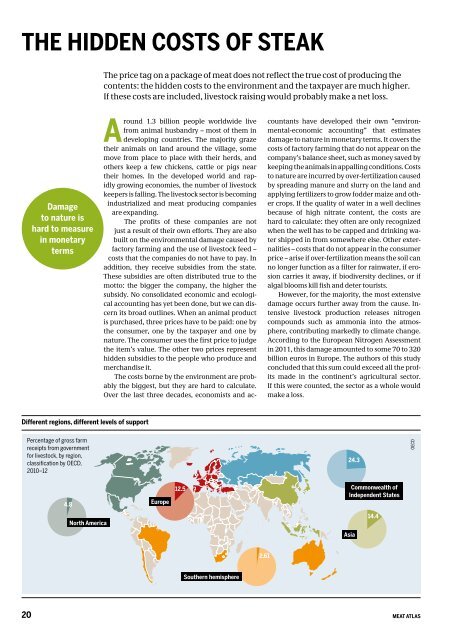1jjtwKx
1jjtwKx
1jjtwKx
You also want an ePaper? Increase the reach of your titles
YUMPU automatically turns print PDFs into web optimized ePapers that Google loves.
THE HIDDEN COSTS OF STEAKThe price tag on a package of meat does not reflect the true cost of producing thecontents: the hidden costs to the environment and the taxpayer are much higher.If these costs are included, livestock raising would probably make a net loss.Damageto nature ishard to measurein monetarytermsAround 1.3 billion people worldwide livefrom animal husbandry – most of them indeveloping countries. The majority grazetheir animals on land around the village, somemove from place to place with their herds, andothers keep a few chickens, cattle or pigs neartheir homes. In the developed world and rapidlygrowing economies, the number of livestockkeepers is falling. The livestock sector is becomingindustrialized and meat producing companiesare expanding.The profits of these companies are notjust a result of their own efforts. They are alsobuilt on the environmental damage caused byfactory farming and the use of livestock feed –costs that the companies do not have to pay. Inaddition, they receive subsidies from the state.These subsidies are often distributed true to themotto: the bigger the company, the higher thesubsidy. No consolidated economic and ecologicalaccounting has yet been done, but we can discernits broad outlines. When an animal productis purchased, three prices have to be paid: one bythe consumer, one by the taxpayer and one bynature. The consumer uses the first price to judgethe item’s value. The other two prices representhidden subsidies to the people who produce andmerchandise it.The costs borne by the environment are probablythe biggest, but they are hard to calculate.Over the last three decades, economists and accountantshave developed their own “environmental-economicaccounting” that estimatesdamage to nature in monetary terms. It covers thecosts of factory farming that do not appear on thecompany’s balance sheet, such as money saved bykeeping the animals in appalling conditions. Coststo nature are incurred by over-fertilization causedby spreading manure and slurry on the land andapplying fertilizers to grow fodder maize and othercrops. If the quality of water in a well declinesbecause of high nitrate content, the costs arehard to calculate: they often are only recognizedwhen the well has to be capped and drinking watershipped in from somewhere else. Other externalities– costs that do not appear in the consumerprice – arise if over-fertilization means the soil canno longer function as a filter for rainwater, if erosioncarries it away, if biodiversity declines, or ifalgal blooms kill fish and deter tourists.However, for the majority, the most extensivedamage occurs further away from the cause. Intensivelivestock production releases nitrogencompounds such as ammonia into the atmosphere,contributing markedly to climate change.According to the European Nitrogen Assessmentin 2011, this damage amounted to some 70 to 320billion euros in Europe. The authors of this studyconcluded that this sum could exceed all the profitsmade in the continent’s agricultural sector.If this were counted, the sector as a whole wouldmake a loss.Different regions, different levels of supportPercentage of gross farmreceipts from governmentfor livestock, by region,classification by OECD,2010–1224.3OECD4.8Europe12.5Commonwealth ofIndependent StatesNorth America14.4Asia2.61Southern hemisphere20MEAT ATLAS


